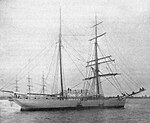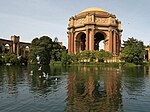Long Now Foundation

The Long Now Foundation, established in 1996, is an American non-profit organization based in San Francisco that seeks to start and promote a long-term cultural institution. It aims to provide a counterpoint to what it views as today's "faster/cheaper" mindset and to promote "slower/better" thinking. The Long Now Foundation hopes to "creatively foster responsibility" in the framework of the next 10,000 years. In a manner somewhat similar to the Holocene calendar, the foundation uses 5-digit dates to address the Year 10,000 problem (e.g., by writing the current year "02022" rather than "2022"). The organisation's logo is X, a capital X with an overline, a representation of 10,000 in Roman numerals.
Excerpt from the Wikipedia article Long Now Foundation (License: CC BY-SA 3.0, Authors, Images).Long Now Foundation
Marina Boulevard, San Francisco
Geographical coordinates (GPS) Address Nearby Places Show on map
Geographical coordinates (GPS)
| Latitude | Longitude |
|---|---|
| N 37.8064591 ° | E -122.4321258 ° |
Address
Landmark Building A
Marina Boulevard
94123 San Francisco
California, United States
Open on Google Maps









